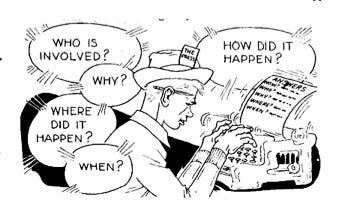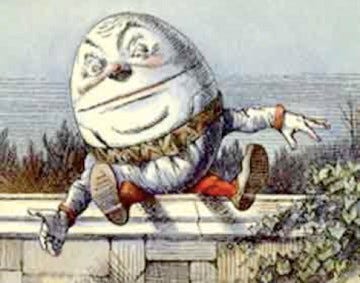Lessons for new storytellers and student journalists
That's my learning style, and this is a reflective essay and a fun, engaging way to teach students, colleagues, employees, and staff. Give them the tools: Why? What? How? Demonstrate!

The point of journalism, I believe, is to roll up your sleeves and get down to business because there is no time to waste. Everything you learn on your first newspaper job you learn the hard way, and I brought that with me when I became a high school journalism teacher.
I was only seven years older than my first group of students when I was hired to teach journalism and photography at Roseburg (OR) Senior High School. I knew how much high school students hate to be talked at or—even worse—lectured; therefore, I cooked up an evil scheme to teach them everything the hard way—as a kind of prank—and to never pull the same prank on them twice.
It taught them to think on their feet, question everything, and tackle the problem at hand—pretty much the way we were taught at UO School of Journalism. I didn't really have time to talk or lecture, anyway—we published a high school newspaper every two weeks! When I did speak, it was direct, to the point, and ideally funny in that epiphany kind of way, mind blown, that reveals new ways of seeing and thinking.
I had expert help along the way. Journalists do it daily, are accessible, and willing to share tips, and I’m lucky and grateful that Calvin Trillin, who wrote the U.S. Journal column for The New Yorker in 1972, for spending part of a day with me to write his column about our small town divided over two different police chief styles.
I had written about it first as a junior for our high school newspaper, which he became aware of, and continued to cover when I was the editor of the local weekly newspaper while completing the last semester of high school in Cloverdale. I continued working summers during college as guest editor of weekly newspapers in Sonoma County.
I am an avid reader, especially of anything written by someone with a newspaper or journalism background, and I hate to reinvent the wheel if there's already something handy I can use. (Who doesn't love Bob Greene's "Be True To Your School" or Karen Karbo's "The Stuff of Life," for example?) Sometimes, though, it wasn't quite in the form I needed it for a high school audience, so I adapted it.
Nora Ephron, one of the pioneers of literary journalism movement, inspired my very first Day One lesson, based on a column she wrote for Esquire. It was a piece about the best teacher she ever had, her high school journalism teacher, and appealed to me because hey, who doesn't want to learn how to be the best, and I was about to face a classroom of teenagers solo for the first time!
Actually, I'm also grateful to her journalism teacher at Beverly Hills High School in 1956-57, because he created the lesson she wrote about that I adapted. He dictated a set of facts, and students had to take them and write the first paragraph of a news story.
Beginning Journalism, Day 1: I followed his lead and dictated facts, in the beginning just swapping out local names for the example, and later inventing my own stories to keep it fresh: "The principal of Roseburg Senior High School announced today the faculty would travel to Eugene on Monday for a workshop on new teaching methods. Speaking there will be anthropologist Margaret Mead, educator Robert Maynard Hutchins, and several others.”
Challenge: Compose your news lead using the facts above, but don’t peak at the answer in the next paragraph until it’s done!
We did a read-around of everyone’s leads, which almost always was fed back in the opposite order from what I had just dictated: “Margaret Mead and Robert Maynard Hutchins will lead a workshop…” and after everyone had smugly patted themselves on the back for a job well done, I would simply say, just as in the story Ephron wrote, “The lead is, ‘There will be no school on Monday.’”
As Ephron wrote in her column: “It was an electrifying moment. So that’s it, I realized. It’s about the point.”
Beginning Journalism, Day 2: “Today, you are going to learn how to write a news story, but I haven’t taught you how to gather information and interview people yet. Instead, you are going to turn a fairy tale into a news story.”
We would then list all the fairy tales they knew and choose one, recap some of the plot points and literary devices. (In later years, many of my students were unfamiliar with fairy tales, or children’s stories, so I began reading some of my favorites to them.)
Then I would draw the inverted pyramid on the board and tell them the story had to start with the latest and most important information first, and work backwards from there. (Gotta love journalism for the use of the half-time lockerroom chalk talk!)
The great thing about fairy tales is they are told in narrative chronological form, unlike a news story. Many of them were in chronological form, so they had to rewrite it. Another hard-luck lesson.
Sometimes, beginning writers just needed to see an example to get it, but I always made them write their story first, then we would analyze where they went right or wrong, and then I would show them the example if they wanted me to. Believe it or not, much of the time they would immediately get what they did wrong and wanted to fix it rather than see an example.
I think it’s a fun writing assignment, and I’m sharing the one I wrote, my favorite example, using the poem ”Humpty Dumpty.”
Instructions: “Write a news story,” and the admonition that “This will be the only time I will ever allow you to make up facts, so make it good!”
Then have everyone read their stories aloud to the rest of the class. It’s really a lot of fun and is a great way to start in a journalism class—fun, and hard work!
Here’s the poem:
Humpty Dumpty sat on a wall
By Mother Goose
Humpty Dumpty sat on a wall,
Humpty Dumpty had a great fall;
All the king's horses and all the king's men
Couldn't put Humpty together again.
Source: The Dorling Kindersley Book of Nursery Rhymes (2000)
If you’ve got a little time on your hands these days, it might be kind of fun to rummage through your own books and try writing your own short news story!
I always write with them on this assignment. Here’s what I wrote:
Illustration of Humpty Dumpty from Through the Looking Glass, by John Tenniel, 1871.
Memorial service planned for fun-loving but fragile friend
By Rob Melton
Fairy Tale News Service
FAIRYLAND — Officials are scrambling to get ready for a memorial service tomorrow at 3 p.m. in the Our Lady of Perpetual Omelet church honoring Humpty Dumpty. Friends and acquaintances were broken up over the unexpected demise of their wise-cracking comrade.
His remains will be cream-aided along with his favorite cheese, medium cheddar, and jalapeño Tobasco.
“He was one spicy dish,” cooed one of the chicks who witnessed the tragedy. “There was so much of him to love.”
The stout AAA-sized egg fell off a wall Monday after showing off to a group of teen-eggers and losing his balance.
“Here’s a Humpty, there’s a Humpty, every where a Humpty Dumpty,” said farmer Auld McDonald. A group of hens nearby clucked in agreement.
“He was a good egg, one of the best I ever met,” Little Red Hen said. “He always had a funny yoke for everyone., He wasn’t eggotistical at all,” Henny Penny said.
“He was certainly a big cheese around here,” mayor Jack Sprat said. “He was loved by all.”
-30-
Writing challenge: What was your best learning experience? Why? What did you learn about yourself? How do you prefer to learn something new?
Thanks to you we now have more than 260 subscribers and followers. When you Subscribe you get the latest posts in your email so you never miss a post. Posts and Notes are always free when you Subscribe. When I turned on payments I noticed there are more features under the hood available. We even reached #81 and Rising in Education last week.
Four steps to improve lessons, and five strategies to engage student learning
This is a process piece that explains effective lesson design, which helps teachers implement a continuous improvement process in the classroom involving student self-reflection and putting them in charge of their learning, and the unspoken barriers that get in the way.





